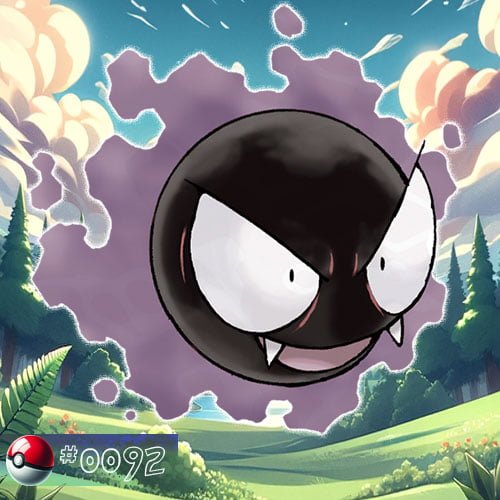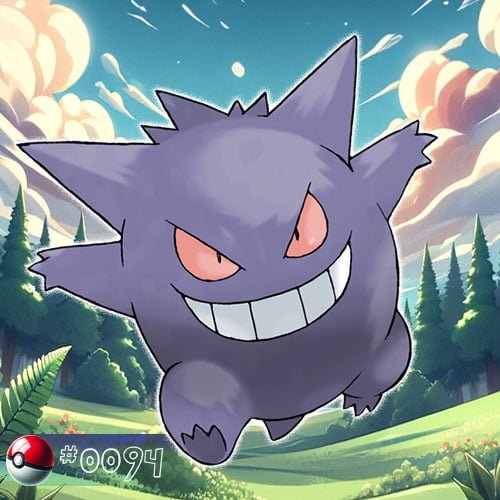Haunter
Haunter is a Ghost/Poison-type Pokémon known for its mischievous and playful nature. It is the evolved form of Gastly and evolves into Gengar when traded. Haunter is recognized for its spectral appearance, levitation, and the ability to phase through walls.
Biology
Physical Characteristics
Haunter is a distinctive Pokémon with unique physical characteristics.
Haunter’s body is ethereal and translucent, resembling a dark, swirling mass of gas or shadows. Its ghostly appearance aligns with its Ghost-type classification, contributing to an eerie and supernatural aura.
Haunter doesn’t have visible legs or a solid form, indicating its ability to float in the air without the need for physical support. It hovers at a certain height, showcasing its levitation capabilities.
Haunter’s eyes are notably large, and they often emit a mysterious glow, emphasizing its spectral nature. The eyes are expressive, reflecting Haunter’s mischievous and playful demeanor. Each of Haunter’s hands is characterized by three elongated and sharp fingers, resembling claws. These hands add a touch of spookiness and contribute to its ghostly appearance.
Haunter is associated with emitting toxic gas, a manifestation of its Poison-type attributes. This gas can be harnessed for various moves and attacks, showcasing Haunter’s strategic combat abilities. Haunter’s body is gaseous and lacks a solid structure, allowing it to pass through solid objects effortlessly. This intangibility adds to its ghostly nature, making it a tricky and elusive Pokémon in battles.
These detailed physical characteristics collectively define Haunter’s unique and otherworldly design, setting it apart as a memorable and iconic Pokémon in the Pokémon universe.
Behaviour
Haunter is known for its mischievous and playful nature, often engaging in pranks and tricks on both humans and other Pokémon. It enjoys causing confusion and surprises, reflecting its love for amusement.
Haunter is associated with a distinctive, eerie laughter that can be heard when it’s nearby. The sound of its laughter adds to the spooky atmosphere it creates, instilling a sense of mystery. Haunter’s large, expressive eyes convey a range of emotions, from amusement to mischief. Its eyes are a key element in its communication, enabling it to convey intentions and reactions.
Due to its levitation abilities, Haunter hovers and floats in the air, demonstrating a ghostly and supernatural behavior. This hovering nature allows Haunter to move silently and unpredictably. Haunter’s ability to pass through solid objects showcases a unique behavior. It uses this intangibility to surprise and confound opponents during battles.
Haunter utilizes its Poison-type abilities to emit toxic gas during battles. This gas not only serves as an offensive tactic but also adds a strategic element to Haunter’s behavior in combat situations. Haunter is often more active during the nighttime, aligning with its ghostly and nocturnal characteristics. Its behavior may change depending on the time of day, becoming more animated during the darkness.
Trainers who form strong bonds with Haunter find it to be a loyal and reliable companion. Despite its mischievous nature, Haunter can be fiercely protective of those it considers friends.
These behavioral traits contribute to Haunter’s enigmatic and captivating personality, making it a fascinating Pokémon with a mix of playful antics and strategic prowess.
Evolution
Haunter undergoes a unique evolution process, transitioning through different stages in its evolutionary line. Here’s a detailed exploration of Haunter’s evolution.
Gastly evolves into Haunter starting at level 25. Gastly, a Ghost/Poison-type Pokémon, evolves through leveling up, reflecting its growth and development. The evolution results in Gastly transforming into Haunter, with notable changes in appearance. Haunter gains additional features such as larger hands and a wicked smile.
Haunter evolves into Gengar through a process known as trade evolution. Haunter, when traded between Pokémon Trainers, undergoes a unique transformation into Gengar. The evolution from Haunter to Gengar is significant, involving a shift in appearance and characteristics. Gengar is larger and has a more menacing presence compared to Haunter.
Gengar represents the final stage of evolution in this evolutionary line. Like its pre-evolutions, Gengar maintains the Ghost/Poison typing, showcasing its supernatural and toxic attributes. Gengar possesses distinct traits, including a sinister grin, levitation abilities, and a shadowy, ghostly aura. Gengar does not evolve into another Pokémon, making it the terminal stage in this evolutionary line.
Gengar is renowned for its potent abilities, agility, and mischievous behavior, making it a formidable presence in battles. Gengar can undergo Mega Evolution into Mega Gengar when exposed to a Gengarite Mega Stone. Mega Evolution is a temporary and battle-specific transformation, enhancing Gengar’s stats and altering its appearance during battles.
Gengar is also capable of Gigantamaxing, a phenomenon specific to certain Pokémon in the Galar region. In its Gigantamax form, Gengar transforms into a massive serpent-like creature with a red, glowing eye on its chest. Gigantamax Gengar gains access to exclusive G-Max moves, making it a formidable force in Dynamax battles.
Haunter’s evolution is characterized by a trade-induced transformation into Gengar, offering Trainers a powerful and iconic Ghost-type Pokémon with unique abilities and characteristics. The Mega Evolution, and Gigantmax evolution options further add strategic depth to its evolutionary journey.
Appearances
Anime Main Appearances
Sabrina’s Haunter
In “The Tower of Terror”, Ash made friends with a mischievous Haunter. Initially, he enlisted Haunter’s help to face Sabrina, the Gym Leader of Saffron City’s Gym, and rescue his captured friends. However, at the end of ”Haunter Versus Kadabra”, Haunter, known for its playful nature, chose humor over battle. In the end, Haunter assisted Ash in making Sabrina laugh, and rather than joining Ash’s team, it opted to stay with Sabrina.
In various episodes, Haunter and its evolutions, Gastly and Gengar, play mischievous and spooky roles. Other appearences include:
- “A Shipful of Shivers” (A Haunter and a Gastly guarded their deceased Trainer’s Orange League trophy.)
- “Illusion Confusion!” (A group of Haunter and Gengar created obstacles for Ash and friends in a forest.)
- “From Ghost to Ghost” (Morty used a Haunter during a Gym battle against Ash, defeating Cyndaquil but losing to Noctowl.)
- “Hoenn Alone!” (Multiple Haunter seen attacking various Pokémon.)
- “Fear Factor Phony” (A Haunter resided in an abandoned mining colony.)
- PK15 (A Haunter lived in a spooky house.)
- “Scary Hospitality!” (Lon utilized a Haunter to scare visitors.)
- “A Haunted House for Everyone!” (A Haunter played with students and appeared in a dream.)
- “Showdown at the Gates of Warp!” (Ash’s Gengar briefly devolved into Haunter and then Gastly due to Dialga and Palkia’s influence.)
Anime Minor Appearances
A Haunter made a mysterious debut in ”Pikachu’s Rescue Adventure”, featuring in the Japanese credits. It reappeared in ”Destiny Deoxys”’ opening sequence, haunting viewers with its spectral presence. In ”Ghoul Daze!”, Haunter continued to showcase its ghostly allure.
The fantasy-driven scenario in ”Loading the Dex!” portrayed Haunter alongside its evolutionary relatives in a whimsical tale imagined by Meowth. From Mimikyu encounters to playful pretenses as Lopunny, Glaceon, and Gardevoir, Haunter’s enigmatic nature unfolds.
”To Top a Totem!” witnessed Haunter’s participation, while ”Alola, Kanto!” captured its essence through Rotom’s lens. Even in dreams, like ”The Final Four!” and ”The Spectral Express!”, Haunter maintained its eerie charm. Haunter also left a lasting impression in ”This Could be the Start of Something Big!”, hinting at more spectral tales to unravel in the Pokémon world.
A Coordinator’s Haunter was seen in the episodes ”Deceit and Assist” and ”Old Rivals, New Tricks!” (participated in the Sandalstraw Contest).
A Trainer’s Gastly appeared also in the epsodes ”A Shocking Grocery Run!”, ”Balloons, Brionne, and Belligerence!” and ”Securing the Future!” (where it was seen showering Necrozma with light with other Pokémon).
Manga Appearances
The Electric Tale of Pikachu
In ”Haunting My Dreams”, Ash confronted the formidable Black Fog, a colossal Haunter notorious for using Dream Eater to steal souls. Sabrina, harboring a vendetta since her Pokémon fell victim to it, joined forces with Ash and hunters. Despite weakening it for capture, the Black Fog sacrificed itself with Self-Destruct, eluding capture.
Pokémon Adventures
In a flashback from ”Lapras Lazily”, a boy, once acquainted with Blue near the abandoned Power Plant, possessed a Haunter in his team until it was stolen. Later, he confronted Agatha’s Gengar using this Haunter to rescue Blue from a Dream Eater-induced coffin. Agatha deployed armies of Haunter in her Kanto attack, introduced in the same chapter.
In ”A Flaaffy Kerfuffle”, a Haunter was part of Professor Oak’s fantasy about Trainers having only six Pokémon. In ”The Last Battle VI”, Eusine’s Haunter played a crucial role in defeating the Masked Man’s Gastly and rescuing Suicune. In ”The Last Battle XIII”, a Haunter participated in the fight in Ilex Forest. Team Galactic Grunts used multiple Haunter in ”Tackling Tangrowth” and ”Mixing It Up with Machamp”. Additionally, a Rich Boy’s Haunter appeared in ”Deprogramming Porygon-Z”, and another Haunter was seen in ”A Photoshoot and the Abandoned Thrifty Megamart”.
Pokémon Pocket Monsters
In ”Get Rid Of The Ghost Pokémon!!”, Blue owned a Haunter that later evolved into Gengar. Another Haunter appeared in ”Which One is the Real Clefairy!?”, providing a tour. In ”Fierce Competition at the Pokémon Baseball Tournament!”, a Haunter participated in a baseball match. Agatha had a Haunter in ”Panic on the Luxury Liner?!”. Giovanni revealed his Haunter in ”Squirtle, the Crybaby Pokémon”, attempting to battle Squirtle.
Haunter also appeared in the following manga:
Pocket Monsters DP – in the third chapter of the Pocket Monsters DP manga, PMDP03.
Pocket Monsters Platinum: Aim to Be Battle King!! – the second chapter of the Pocket Monsters Platinum: Aim to Be Battle King!! manga, PBK2.
Pokémon Gold & Silver: The Golden Boys – in this manga Black’s Haunter, evolved from a Gastly, and another one appeared in the ”Farewell To Pikachu?!” owned by Eusine.
Pokémon Gotta Catch ‘Em All – in the GDZ34 and GDZ72.
Game data
Stats
Location
| Game version | Location |
|---|---|
| Pokémon Red and Pokémon Blue | Pokémon Tower |
| Pokémon Yellow | Pokémon Tower |
| Pokémon Gold and Pokémon Silver | Route 8 |
| Pokémon Crystal | Route 8, Rock Tunnel |
| Pokémon Ruby and Pokémon Sapphire | Trade |
| Pokémon FireRed and Pokémon LeafGreen | Pokémon Tower, Lost Cave |
| Pokémon Emerald | Trade |
| Pokémon Colosseum | Trade |
| Pokémon XD | Trade |
| Pokémon Diamond and Pokémon Pearl | Old Chateau, Snowpoint City, Turnback Cave |
| Pokémon Platinum | Snowpoint City, Turnback Cave |
| Pokémon HeartGold and Pokémon SoulSilver | Route 8, Safari Zone |
| Pokémon Black | Trade |
| Pokémon White | Evolve Gastly |
| Pokémon Black 2 and Pokémon White 2 | Trade |
| Pokémon X and Pokémon Y | Routes 14 and 19, Frost Cavern, Victory Road |
| Pokémon Omega Ruby and Pokémon Alpha Sapphire | Trade |
| Pokémon Sun and Pokémon Moon | Thrifty Megamart |
| Pokémon Ultra Sun and Pokémon Ultra Moon | Thrifty Megamart |
| Pokémon: Let's Go, Pikachu! and Pokémon: Let's Go, Eevee! | Pokémon Tower |
| Pokémon Sword and Pokémon Shield | Route 8, Giant's Seat |
| Rolling Fields, Watchtower, Giant's Cap, Giant's Mirror, Hammerlocke Hills, Motostoke Riverbank, South Lake Miloch, Stony Wilderness, Watchtower Ruins | Pokémon Tower |
| Pokémon Brilliant Diamond and Pokémon Shining Pearl | Turnback Cave |
| Legends Arceus | Bolderoll Ravine, Celestica Ruins, Cottonsedge Prairie, Gapejaw Bog, Sacred Plaza, Scarlet Bog, Shrouded Ruins |
| Pokémon Scarlet and Pokémon Violet | West Province (Area One), North Province: (Area One), Dalizapa Passage, Glaseado Mountain |
Haunter's origin name
English: The English name “Haunter” reflects its ghostly nature and its tendency to haunt or spook others. It aptly captures the essence of this mischievous Ghost-type Pokémon.
Japanese: In Japan, Haunter is known as “ゴースト” (Gōsuto). The Japanese name directly translates to “Ghost,” emphasizing its spectral and supernatural attributes.
French: In French, Haunter is named “Spectrum.” The name “Spectrum” retains the ghostly theme, referring to a range of ghostly phenomena.
German: In German, Haunter is called “Alpollo.” The German name combines “Alp,” a term associated with nightmares or supernatural beings, with “Apollo,” giving it a mystical and eerie touch.
Spanish: In Spanish, Haunter is known as “Haunter” (pronounced the same way as in English). The Spanish version maintains the English name, with no significant linguistic alterations.
Italian: In Italian, Haunter is named “Haunter” (pronounced similarly to the English version). The Italian name aligns with the English one, preserving the spooky connotation.
Korean: In Korean, Haunter is referred to as “고우스트” (Gouseuteu). The Korean name phonetically adapts the English term “Ghost” into the Hangul script.
Chinese (Simplified): In Simplified Chinese, Haunter is known as “鬼斯” (Guǐ Sī). The name combines characters representing “Ghost” or “Specter.”
Chinese (Traditional): In Traditional Chinese, Haunter is named “鬼斯通” (Guǐ Sī Tōng). The traditional version includes an additional character, “通,” adding depth to its ghostly identity.
Haunter’s names across languages maintain a thematic consistency, emphasizing its ghostly and supernatural characteristics, while some variations add cultural nuances to enhance its mystique.





